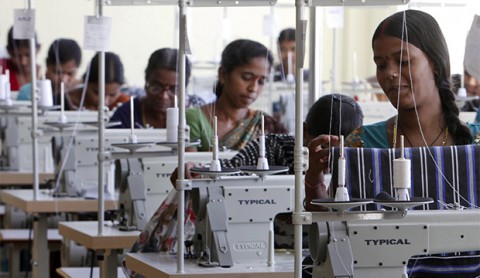A report, published by the Center for American Progress earlier this month, revealed that the meager wages garment workers make, in return for long laborious working days in dangerous conditions, have further decreased over the past decade. The study, prepared by the Worker Rights Consortium, examines 15 of the world’s leading apparel-exporting countries and found that between 2001 and 2011, wages for garment workers in the majority of these countries fell making it nearly impossible for them to afford the minimum necessities of a decent life.
The report, entitled “Global Wage Trends for Apparel Workers,” found that the gap between prevailing wages—the wages paid in general to an average worker—and living wages for garment workers in these countries has only widened. “The most troubling news in this report is that even in countries like Bangladesh and Cambodia—where wages were the lowest and least adequate for workers’ needs—workers’ pay actually stagnated or declined over the last decade,” said Ben Hensler, author of the report and deputy director of the Worker Rights Consortium. “This finding underscores the urgent need for those with the greatest power to lift garment worker wages—not just the governments of these countries, but also the U.S. and European brands and retailers that buy the apparel these workers produce. Meaningful action must be taken to raise minimum wages, pay fairer prices to factories, and give workers the freedom to form unions and bargain collectively on their own behalf.”
In Bangladesh, the world’s second-largest apparel exporter that has come under scrutiny after a deadly factory collapse in April, workers make just 14 percent of a living wage. In the other top three exporters to the U.S., China, Vietnam, and Indonesia, workers make 36 percent, 22 percent, and 29 percent, respectively, as reported in this article.
The report examined the trends from 2001 to 2011 in real wages for apparel-sector workers in 15 of the top 21 manufacturing countries. Key findings from the study include:
- In nine countries—Bangladesh, Cambodia, the Dominican Republic, El Salvador, Guatemala, Honduras, Mexico, the Philippines, and Thailand—the prevailing real wage for apparel-sector workers in 2011 was less than it was in 2001. That is, apparel-sector workers in the majority of countries studied saw their purchasing power decrease and slipped further away from receiving a living wage.
- In the six countries where real wages increased from 2001 to 2011, wage growth in two of the countries, Peru and India, was modest—less than 2 percent per year when adjusted for inflation. While wage gains for workers in Indonesia, Vietnam, and Haiti were more substantial, it would take more than 40 years for the prevailing wage rate to equal a living wage even if their recent rates of real wage growth were sustained.
- Only in China did real wages for apparel-sector workers increase at a rate that would lift workers to the point of receiving a living wage within the next decade. Not surprisingly, the industrial centers in China where workers benefited from these gains have already seen a loss of apparel production, as manufacturers have shifted their facilities, and buyers have shifted their orders, to lower-wage areas both within China and in other countries.
